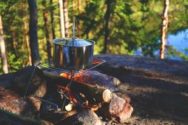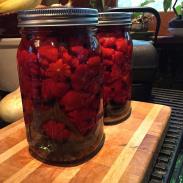
Charcutier Sean Cannon is opening his first restaurant, Nape, in London this month. Born and bred in Norfolk, Sean told the Guardian how growing up in a self-sustaining community influenced his cooking. His best kept secret – preserving.
“Whether it’s killing an animal and having lots of fresh meat, or early summer and everything is ripe, knowing what to do with a glut is key.” Cannon said.
If you live off-grid you’ll know that preserving food for future use is essential. Not only does it provide food security, but also allows you to taste sweet summer berries in the winter. By doing this age old tradition, it also stops more modern thoughts and concerns of “what is actually in my food?” If you do the preparing and the preservation, you know exactly what has gone into the food you will be eating.
There are many ways to preserve food including canning, freezing, dehydrating and smoking.
Canning is a valuable and low-tech way to preserve food. There are two main methods for this, either water bath canning or pressure canning. It is worth noting that water bath canning should only be done for acidic fruits, such as berries and apples. If canning other produce such as meats and vegetables, pressure canning should be used; otherwise there is a high risk of food poisoning.
The basic process is to heat water in your canner (or large pan if water bath canning). This should not be filled to the top; 3-5 inches should be left for your jars of food. Jars should have lids secured and be placed carefully into the canner, being careful not to knock other jars, as they could crack or break under the high temperatures. The jars should be immersed in the canner with the water just covering the lids. The canner lid should be locked in place if pressure canning and the jars left for as long as needed according to the recipe. After the required time, the canner should be allowed to depressurise if using a pressure canner, before the jars are removed. Heat protection and necessary precautions should be taken to ensure you do not burn yourself. The jars should then be left to cool and seal for a minimum of 12 but ideally 24 hours. The sound of popping and pinging will mark your canning success!
Canning is so popular because of the wide variety of foods that can be preserved this way and the length of time they will remain edible for. Plus there’s no worry of keeping food frozen or cool!
Canning does however come with an initial start-up cost. If you’re only looking to preserve fruits and jams, then water bath canning in a large pan is of course an economical way to go. However, if you’re looking to preserve a wider variety of foods which includes meat and vegetables, then it would be wise to invest in a pressure canner.
The Presto 23 Quart Pressure Canner and Cooker comes in at a reasonable $86.44 on Amazon. This can double as a water bath canner and a pressure cooker. Made out of aluminium, the canner allows for fast and even heating and with a liquid capacity of just under 22 litres, seven quart jars fit comfortably inside. The lid has a strong lock and an over-pressure plug can relieve any build-up of steam. With a 12 year warranty and excellent reviews, this canner will certainly suit the needs of most canners.

The Presto’s rival is the All American Canner. This is a pricier option at $225.37 on Amazon and has many similar features, being made of aluminium and also holding 7 quart (or 19 pint) jars. This is a heavier unit though, coming in at 20lbs to the Presto’s 12lbs. A reviewer having access to both canner makes did however point out another comparison between the two. She noted that the All American Canner has a weighted gauge which needs less “babysitting” than the Presto with its dial gauge, which required her to keep adjusting the heat of her stove. However, she pointed out that when compared side by side, both the Presto and All American took the same amount of time to get to pressure, to can the produce and to bring back down ready to remove the jars.
Once the initial canner investment is made, there are a couple of other bits and pieces which you will need. Jars are a must and are reusable. However, if using second hand jars to try and save on cost, it is important not to have any that are cracked or damaged in any way – this could lead to some nasty accidents later on!
In terms of lids, these can either be replaced for around $3 per pack or you could spend a little extra and invest in some reusable Tattler lids. These are marketed at $8.88 on Amazon for a pack of 12 and are “indefinitely reusable”.
Other kit you might want to buy (and are recommended to prevent nasty burns) are a jar lifter and canning funnel. These can be bought separately or in a set with other equipment such as kitchen tongs, a jar wrench and magnetic lid lifter advertised on Amazon at $8.79.
For more detailed information on canning basics for beginners, check out Starry Hilder’s video on YouTube!
Another popular preservation method, especially for meat and fish is smoking.

This involves long exposure to wood smoke at low temperatures, which is different to grilling over an open fire. Smoking preserves meat and fish by drying the produce and the smoke creates an acidic coating on the meat surface, preventing bacterial growth. The addition of a rich mouth-watering smoky flavour only adds to the appeal of this preservation method.
There are two types of smoking method. The first is called hot smoking and cooks the meat so it can be eaten straight away. This involves getting the temperature above 150 degrees Fahrenheit. The meat will still need to be cooked over a long time, leaving it very tender.
The second is cold smoking which doesn’t cook the meat for consumption straight away. Instead temperatures between 75 and 100 degree Fahrenheit are used to seal the meat and flavour it. The time meat or fish is left to smoke depends on the cuts and type of produce. Adding salt to the meat can help to speed up the process as it is a natural preservative. After drying the meat should be placed in an air tight container and stored at a cool temperature until consumed.
There is a wide range of smokers from electric or gas to charcoal and wood. This propane smoker from Amazon comes with a built in temperature gauge and retails at $211.40. Alternatively, instead of trying to find a smoker that suits your needs, why not build your own? That’s what this family has done!
Part II of “Be Our Guest – Food Preservation” will cover refrigeration and dehydrating.